Car seat safety is a paramount concern for parents, as it plays a crucial role in protecting young children in the event of a car accident. Understanding how to choose, install, and use a car seat correctly can make all the difference in the outcome of a collision. Additionally, consulting a car accident attorney in Las Vegas can provide valuable legal guidance if you find yourself in an unfortunate situation. Here’s what every parent needs to know about car seat safety to ensure their child’s protection on the road.
Choosing the Right Car Seat
- Age and Size Appropriateness: Infant Car Seats: Suitable for newborns and babies up to 1 year old or until they reach the weight and height limit specified by the manufacturer. Convertible Car Seats: Can be used rear-facing for infants and toddlers, then converted to forward-facing as the child grows. Booster Seats: Designed for older children who have outgrown their forward-facing seats, typically used until the child is tall enough to use the vehicle’s seat belt.
- Safety Ratings: Look for car seats that meet or exceed safety standards set by organizations like the National Highway Traffic Safety Administration (NHTSA).
- Ease of Use: Choose a car seat that is easy to install and adjust. Features like adjustable harness systems and straightforward installation instructions can ensure better safety
Proper Installation
- Follow Manufacturer’s Instructions: Always read the car seat manual and vehicle owner’s manual for proper installation guidelines.
- Secure Fit: Ensure the car seat does not move more than an inch side-to-side or front-to-back once installed.
- Correct Angle: For rear-facing seats, use the angle indicator to ensure the car seat is reclined correctly to protect the child’s head and neck.
- Use the Tether: For forward-facing car seats, always use the tether strap to secure the top of the car seat to the vehicle.
Harnessing Your Child
- Snug Fit: The harness should be snug against your child’s body. You should not be able to pinch any excess webbing at the shoulder.
- Correct Positioning: The harness straps should be at or below the shoulders for rear-facing seats and at or above the shoulders for forward-facing seats.
- Chest Clip: Position the chest clip at armpit level to keep the harness straps properly aligned.
After an Accident
- Inspect the Car Seat: Even if there is no visible damage, the car seat may have compromised integrity. Check for cracks, broken parts, or loose components.
- Follow Manufacturer Guidelines: Most manufacturers recommend replacing a car seat after any moderate or severe accident. Some may allow continued use after a minor crash if specific criteria are met (e.g., the vehicle could be driven away, no injuries occurred, airbags did not deploy, no visible damage to the car seat, and the car door nearest the car seat was not damaged).
- Contact the Manufacturer: If you are unsure whether the car seat needs to be replaced, contact the manufacturer for guidance.
- Insurance Coverage: Check with your insurance company to see if they cover the cost of replacing the car seat after an accident.
Additional Safety Tips
- Regular Checks: Routinely check the car seat for wear and tear, including the harness straps and buckles.
- Avoid Second-Hand Seats: If possible, avoid using second-hand car seats, as they may have unseen damage or be missing essential parts. If you must use one, ensure it has not been in a crash, has all its parts, and comes with the original manual.
- Stay Updated: Car seat technology and safety standards evolve. Stay informed about recalls and safety updates for your car seat model.
Car seat safety is an essential aspect of protecting your child on the road. By choosing the right car seat, ensuring proper installation and harnessing, and knowing what to do after an accident, you can significantly reduce the risk of injury to your child in a car crash. Regularly reviewing safety practices and staying informed about the latest guidelines will help keep your little ones safe on every journey.








Leave a Reply